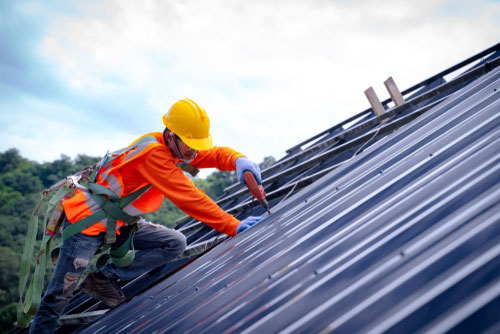Contact a top-rated Toledo Roofer for efficient roofing services.
Contact a top-rated Toledo Roofer for efficient roofing services.
Blog Article
How to Review Different Roof Covering Alternatives for Your Building Needs
Examining roof covering choices for your building needs a comprehensive technique that thinks about numerous elements such as the intended use the structure, regional climate conditions, and product features. It is important to consider the benefits and drawbacks of different roof types, from asphalt roof shingles to metal and clay ceramic tiles, while likewise considering preliminary costs and long-term upkeep. In addition, comprehending power performance and visual appeal can influence your decision. As you contemplate these factors to consider, one question remains: which factors will eventually direct your option for a sustainable and visually pleasing roofing remedy?
Examining Your Building's Requirements
To properly review roof covering choices, start by completely analyzing your structure's demands. Beginning by taking into consideration the structure's meant usage, as different structures might require varying roof covering specifications. Household roofing systems commonly focus on looks and insulation, while commercial structures might focus on resilience and load-bearing capacity.
Following, review the local environment conditions that will influence roof covering performance. Aspects such as temperature variations, rainfall degrees, and wind patterns can affect product selection and design. A roof that succeeds in a warm climate may not do too in areas vulnerable to hefty snowfall or severe warm.
In addition, assess the structural honesty of your structure. Make certain that the existing framework can support the picked roofing materials, particularly if taking into consideration larger options. It is additionally important to evaluate any kind of neighborhood structure codes or laws that may dictate details needs for roof.

Contrasting Roofing Products
Once a comprehensive assessment of your structure's needs has actually been completed, the next action entails contrasting various roof materials. Each material offers unique benefits and negative aspects, making it vital to align your selection with your details needs and circumstances.
Asphalt tiles are extensively identified for their cost and simplicity of installation, making them a popular option for residential buildings. On the other hand, steel roof, known for its longevity and longevity, can hold up against severe climate condition however may feature a higher first financial investment.
Clay and concrete tiles supply exceptional thermal insulation and visual charm, specifically for Mediterranean-style style, yet they require a more robust architectural assistance because of their weight. Wood shakes offer an all-natural look and good insulation residential properties but may demand a lot more upkeep and are vulnerable to fire threats.
Evaluating Cost and Spending Plan
Evaluating your roof options demands a mindful analysis of expense and budget plan factors to consider. The overall allocate a roof job makes up numerous aspects, consisting of material expenses, labor expenditures, maintenance, and potential lasting financial savings. It is important to establish a clear budget prior to exploring details roof covering materials, as this will direct the decision-making procedure and help you prevent overspending.
Begin by obtaining quotes from numerous professionals to recognize labor expenses in your region. Make sure that these estimates include all required services, such as elimination of the old roof covering, installment, and any type of extra features, like insulation or ventilation renovations - Roofer. Next, evaluate the price of numerous roofing materials, thinking about both first installation expenses and expected life expectancy

Understanding Energy Performance
Power effectiveness plays an essential duty in the selection of roof covering products and systems, considerably affecting both power intake and total comfort within a building. A well-chosen roof covering can improve thermal efficiency, reducing the demand for heating and cooling systems, which subsequently lowers energy expenses and reduces ecological impact.
When examining roofing choices, take into consideration materials that show instead than take in heat. In addition, proper insulation and air flow are important to enhance the energy performance of the entire roofing system.
One more essential factor is the roofing system's durability and upkeep demands. Durable products that require less frequent substitute add to lasting energy savings. The power efficiency of a roofing system can also be evaluated via its conformity with well-known sustainability scores such as Power STAR or LEED.
Taking Into Consideration Visual Appeal
A roofing's aesthetic charm substantially influences the general look of a structure, matching its architectural design and enhancing curb allure. Roofer. When assessing roof choices, it is necessary to consider just how the chosen material, color, and layout will balance with the existing framework and community. A properly designed roof covering can elevate even the most basic of structures, transforming them into visual prime focus
Various roof products offer various visual qualities. As an example, traditional roof shingles may evoke a traditional beauty, while steel roofing can pass on a contemporary, smooth look. Additionally, the color of the roof product plays a crucial function; lighter shades can make a building show up even more roomy, while darker tones may produce a cozier setting.
Furthermore, building aspects, such as dormers and eaves, can improve the roofing system's aesthetic impact. It is suggested to seek advice from with expert developers or designers to guarantee the selected roof covering alternative lines up with the overall layout intent. Ultimately, a roofing system should not only visit this site right here give functional benefits but also add positively to the structure's visual, reflecting the see page proprietor's taste and the personality of the surrounding environment.
Conclusion

Report this page